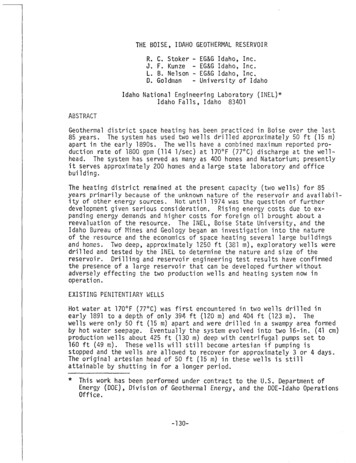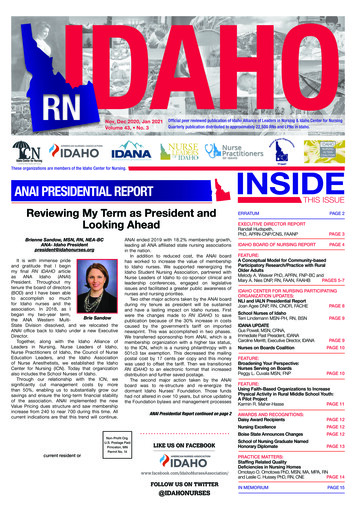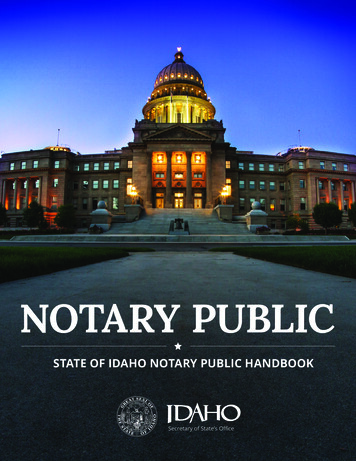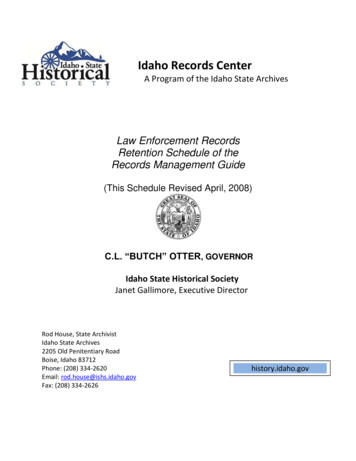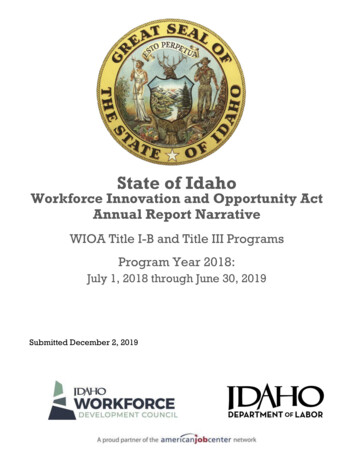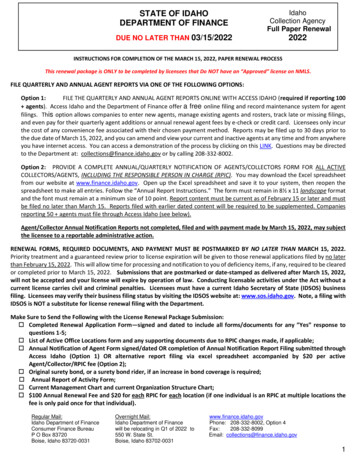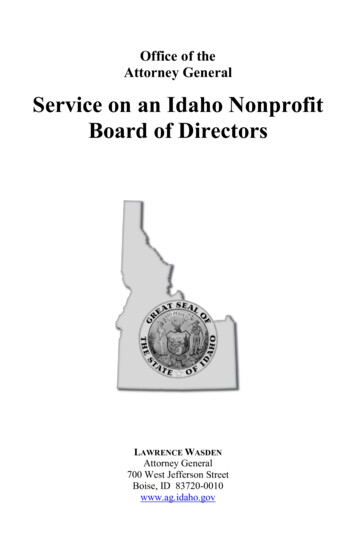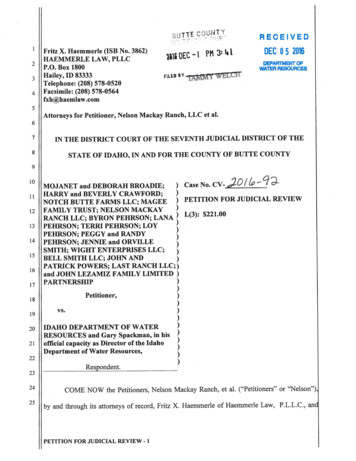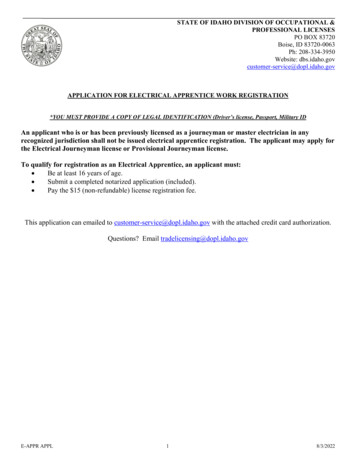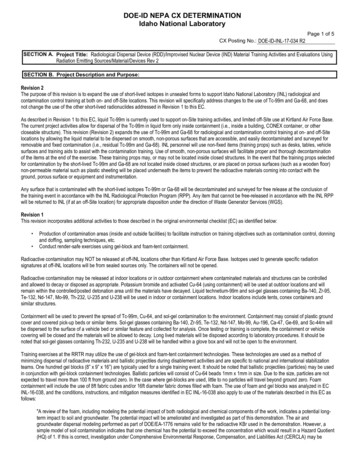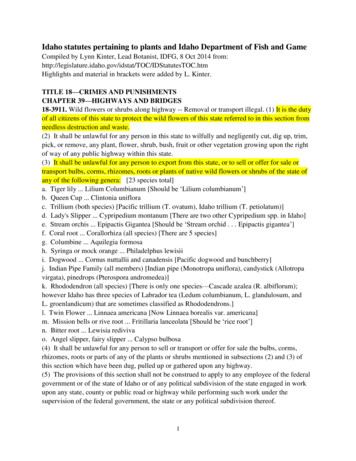
Transcription
Idaho statutes pertaining to plants and Idaho Department of Fish and GameCompiled by Lynn Kinter, Lead Botanist, IDFG, 8 Oct 2014 tutesTOC.htmHighlights and material in brackets were added by L. Kinter.TITLE 18—CRIMES AND PUNISHMENTSCHAPTER 39—HIGHWAYS AND BRIDGES18-3911. Wild flowers or shrubs along highway -- Removal or transport illegal. (1) It is the dutyof all citizens of this state to protect the wild flowers of this state referred to in this section fromneedless destruction and waste.(2) It shall be unlawful for any person in this state to wilfully and negligently cut, dig up, trim,pick, or remove, any plant, flower, shrub, bush, fruit or other vegetation growing upon the rightof way of any public highway within this state.(3) It shall be unlawful for any person to export from this state, or to sell or offer for sale ortransport bulbs, corms, rhizomes, roots or plants of native wild flowers or shrubs of the state ofany of the following genera: [23 species total]a. Tiger lily . Lilium Columbianum [Should be ‘Lilium columbianum’]b. Queen Cup . Clintonia uniflorac. Trillium (both species) [Pacific trillium (T. ovatum), Idaho trillium (T. petiolatum)]d. Lady's Slipper . Cypripedium montanum [There are two other Cypripedium spp. in Idaho]e. Stream orchis . Epipactis Gigantea [Should be ‘Stream orchid . . . Epipactis gigantea’]f. Coral root . Corallorhiza (all species) [There are 5 species]g. Columbine . Aquilegia formosah. Syringa or mock orange . Philadelphus lewisiii. Dogwood . Cornus nuttallii and canadensis [Pacific dogwood and bunchberry]j. Indian Pipe Family (all members) [Indian pipe (Monotropa uniflora), candystick (Allotropavirgata), pinedrops (Pterospora andromedea)]k. Rhododendron (all species) [There is only one species—Cascade azalea (R. albiflorum);however Idaho has three species of Labrador tea (Ledum columbianum, L. glandulosum, andL. groenlandicum) that are sometimes classified as Rhododendrons.]l. Twin Flower . Linnaea americana [Now Linnaea borealis var. americana]m. Mission bells or rive root . Fritillaria lanceolata [Should be ‘rice root’]n. Bitter root . Lewisia redivivao. Angel slipper, fairy slipper . Calypso bulbosa(4) It shall be unlawful for any person to sell or transport or offer for sale the bulbs, corms,rhizomes, roots or parts of any of the plants or shrubs mentioned in subsections (2) and (3) ofthis section which have been dug, pulled up or gathered upon any highway.(5) The provisions of this section shall not be construed to apply to any employee of the federalgovernment or of the state of Idaho or of any political subdivision of the state engaged in workupon any state, county or public road or highway while performing such work under thesupervision of the federal government, the state or any political subdivision thereof.1
(6) The provisions of this section shall not be construed to apply to the owner of any tract ortracts of land, or to his agents or employee, as to such tract or tracts, or to any shrub, plant orother vegetation which is declared by law to be a public nuisance.(7) Nothing in this section shall be construed as prohibiting the digging, pulling, gathering orsending out of this state, at such times the Idaho transportation department may approve, anypropagated plants or shrubs mentioned in subsections (2) and (3) of this section, in such quantityand at such times as the agency or persons having control of the land, public or private, maydetermine and approve.History: I.C., sec. 18-3911, as added by 1972, ch. 336, sec. 1, p. 926; am. 1974, ch. 12, sec. 87, p. 61.[All four sections added in 1967—House Bill 95; Idaho Session Laws 1967, pp. 1415-1417.]18-3912. Prosecution of violators -- Duty of transportation department. Insofar as the statehighway system is concerned, it shall be the duty of the Idaho transportation department and ofall its employees to present evidence of any violation of the provisions of this act to theprosecuting attorney of the county in which any such violations occur. Such prosecuting attorneyshall prosecute any person guilty of a violation of the provisions of this act.History: I.C., sec. 18-3912, as added by 1972, ch. 336, sec. 1, p. 927; am. 1974, ch. 12, sec. 88,p. 61.18-3913. Wild flowers protected -- Amended list -- Duty of department of fish and game. (a) Inorder to further protect native wild flowers and shrubs from needless destruction and waste, thedepartment of fish and game may, after investigation and public hearings and in accordance withthe provisions of this act, establish and amend a list of wild flowers and shrubs in addition tothose listed in section 18-3911(3), Idaho Code. The provisions of this act will then apply to such"established" or "amended" list.(b) In determining additions to the list of wild flowers set forth herein, the department of fishand game may take into consideration:(1) The laws and regulations of the United States and other states.(2) The effect on the scenic beauty of public roads and public land.(3) The necessity to preserve and protect native plants whenever it appears that they mightpossibly become extinct.History: I.C., sec. 18-3913, as added by 1972, ch. 336, sec. 1, p. 927; am. 2003, ch. 129, sec. 1,p. 380.18-3914. Violation a misdemeanor. A violation of this chapter and regulations authorized by thisact is a misdemeanor unless the violation is defined as an infraction.[An infraction is less than a misdemeanor.]2
History: I.C., sec. 18-3914, as added by 1972, ch. 336, sec. 1, p. 928; am. 2001, ch. 289, sec. 2,p. 1027.TITLE 36—FISH AND GAMECHAPTER 24—SPECIES CONSERVATION36-2401. Definitions. As used in this title, the following terms have the following meaningsunless the context indicates otherwise:(1) "Best scientific and commercial data available" means that where this chapter requires theuse of the best scientific and commercial data available, the state, when evaluating comparabledata, shall give greater weight to scientific or commercial data that is empirical or has been fieldtested or peer reviewed.(2) "Candidate conservation agreements" means agreements, entered into with the fish andwildlife service or the national marine fisheries service (services), to implement mutually agreedupon conservation measures for a proposed or candidate species, or a species likely to become acandidate or proposed candidate in the near future, that include assurances from the services thatadditional conservation measures above and beyond those contained in the agreement will not berequired, and that additional land, water or resource use restrictions will not be imposed uponthem should the species become listed in the future.(3) "Candidate species" means a species for which the secretary of interior or secretary ofcommerce has on file sufficient information on biological vulnerability and threats to support aproposal to list the species as an endangered species or a threatened species, but for which listingis precluded because of pending proposals to list species that are of a higher priority.(4) "Endangered species" means those species listed as endangered pursuant to 16 U.S.C. section1532(6).(5) "Habitat conservation plan" means a plan submitted pursuant to a permit as provided in 16U.S.C. section 1539, et seq.(6) "Listed species" means threatened or endangered species.(7) "Rare and declining species" means those species in need of additional managementconsideration due to natural rarity, downward trends in populations and habitats, or other factors,natural or human, that, without additional management, might be listed as threatened orendangered species under the ESA in the future.(8) "Recovery plans" means federal plans or conservation programs, referenced in 16 U.S.C.section 1533(f), that set forth the actions designed to assure the continued survival and recoveryof the species listed as "endangered" or "threatened" pursuant to the endangered species act.(9) "Species conservation assessment" means a state analysis, based on the best scientific andcommercial data available, about the status of a rare or declining species throughout its rangewhich describes current and anticipated factors limiting the viability of the species as it relates todesired goals and objectives and identifies specific research needs relative to the species.(10) "Species conservation strategy" means a state strategic plan for the management orconservation of a rare or declining species that describes the species needs in terms of habitatneeds, population size, distribution and connectivity. The strategy shall include voluntary,landowner-based incentives and measures to achieve the management or conservation goals.3
(11) "Species management plan" means a plan which provides for the consideration andmanagement of a species upon its being delisted.(12) "State conservation programs" means the programs developed, pursuant to 16 U.S.C.section 1535(c), for the conservation of endangered species and threatened species.(13) "Threatened species" means those species listed as threatened pursuant to 16 U.S.C. section1532(20).History: 36-2401, added 2000, ch. 270, sec. 2, p. 772.36-2402. Delisting advisory team -- Duties -- Membership. (1) The director of the department offish and game for animal species and plant species, in cooperation and consultation with thegovernor's office of species conservation, may establish a delisting advisory team (DAT) of nomore than nine (9) members for a threatened species or endangered species, to recommend anappropriate state species management plan for a listed species in response to a notification fromthe secretary of interior or secretary of commerce of intent to delist the species or sooner ifdeemed appropriate.(2) The delisting advisory team members shall be broadly representative of the constituencieswith an interest in the species and its management or conservation and in the economic or socialimpacts of management or conservation including, where appropriate, depending on the specificspecies, representatives of tribal governments, local governments, academic institutions, privateindividuals and organizations and commercial enterprises. The delisting advisory team membersshall be selected based upon:(a) Their knowledge of the species;(b) Their knowledge and expertise in the potential conflicts between a species' habitatrequirements or management and human activities;(c) Their knowledge and expertise in the interests that may be affected by species managementor conservation; or(d) Other factors that may provide knowledge, information, or data that will further the intent ofthis act.History: 36-2402, added 2000, ch. 270, sec. 2, p. 773; am. 2003, ch. 129, sec. 2, p. 380.36-2403. Operations of delisting advisory team. (1) The delisting advisory team shall elect ateam leader who shall chair all meetings of the team and otherwise administer its operations. Theteam shall meet as necessary, but shall meet no less than once every six (6) months.(2) Members of the team not in the employ of public agencies may be compensated as providedin section 59-509(b), Idaho Code, from the budget of the governor's office of speciesconservation. Their department or division shall compensate its members of the team who arestate employees.History: 36-2403, added 2000, ch. 270, sec. 2, p. 773.4
36-2404. State delisting management plan requirements. (1) The delisting advisory team shalldevelop a state management plan for a species in response to all notification of intent to delist thespecies by the secretary of interior or secretary of commerce or sooner if deemed appropriate.The state management plan shall provide for the management and conservation of the speciesonce it is delisted, and contain sufficient safeguards to protect the health, safety, private propertyand economic well-being of the citizens of the state of Idaho.(2) The department of fish and game shall provide the delisting advisory teams, theinformational, technical or other needs and requirements of those teams in the performance oftheir duties.(3) In developing state delisting management plans, the delisting advisory team shall consultwith the appropriate state agencies, commissions and boards. The appropriate state agency forwildlife biological and species management issues, and for plant life biological and speciesmanagement issues is the department of fish and game. The appropriate state agency for timberharvest activities, oil and gas exploration activities and for mining activities is the department oflands. The appropriate state agencies for agricultural activities are the department of agricultureand the Idaho state soil and water conservation commission. The appropriate state agency forpublic road construction is the transportation department. The appropriate state agency for waterrights is the department of water resources. The appropriate state agency for water quality is thedepartment of environmental quality. The appropriate state agency for outfitting and guidingactivities is the Idaho outfitters and guides licensing board.History: 36-2404, added 2000, ch. 270, sec. 2, p. 773; am. 2001, ch. 103, sec. 12, p. 264; am.2003, ch. 129, sec. 3, p. 380; am. 2010, ch. 279, sec. 24, p. 746.36-2405. Recommendation on management plans. (1) The delisting advisory team shall submitthe management plan to the director of the department of fish and game for animal or plantspecies, for review and recommendation.(2) The director shall review the management plan and make a recommendation to the fish andgame commission. The director may recommend either approval of the management plan, orrecommend to return the management plan to the delisting advisory team for further study andreview, with instructions, prior to return of the species strategy or management plan to thedirectors.(3) If the fish and game commission finds that the management plan provides for themanagement and conservation of the species when it is delisted by the secretary of the interior orsecretary of commerce and that reasonable safeguards are included in the management plan toprotect the health, safety, private property and economic well-being of the citizens of the state ofIdaho, the fish and game commission shall approve the management plan.(4) If the fish and game commission makes the finding required in subsection (3) of this section,the fish and game commission shall forward the state management plan, to the governor's officeof species conservation and the legislature. The management plan is subject to legislativeapproval, amendment or rejection by concurrent resolution at the regular session immediatelyfollowing the commission's finding and approval of the plan.5
(5) The governor's office of species conservation may petition the responsible public agencies toinitiate rulemaking to facilitate the implementation of the approved management plan.(6) Each management plan developed pursuant to this chapter shall include a public educationcomponent that shall be developed and implemented in cooperation with other appropriatebureaus of the department of fish and game.(7) Nothing in this act shall be interpreted as granting the department of fish and game with newor additional authority.History: 36-2405, added 2000, ch. 270, sec. 2, p. 774; am. 2003, ch. 129, sec. 4, p. 381.TITLE 67—STATE GOVERNMENT AND STATE AFFAIRSCHAPTER 8—EXECUTIVE AND ADMINISTRATIVE OFFICERS—GOVERNOR ANDLIEUTENANT-GOVERNOR67-818. Coordination of policy and programs related to threatened species and endangeredspecies in Idaho. (1) There is hereby created in the office of the governor, the "Office of SpeciesConservation." The administrator of the office of species conservation shall be the official in thestate designated to oversee implementation of federal recovery plans, as provided in 16 U.S.C.section 1533(f), and to fulfill the duties provided by this section. The administrator shall beappointed by, and serve at the pleasure of, the governor and shall be subject to confirmation bythe state senate.(2) The duties of the office of species conservation shall include:(a) Coordination of all state departments and divisions with duties and responsibilities affectingendangered species, threatened species, candidate species, species petitioned to be listed, andrare and declining species as defined in section 36-2401, Idaho Code;(b) Coordinating state implementation and response to federal recovery plans, biologicalopinions, guidance and projects among all state and local governments in the state of Idaho;(c) Participation in regional efforts to cooperatively address endangered species, threatenedspecies, candidate and petitioned species, and rare and declining species;(d) Providing input and comment to federal and state agencies, and tribes on issues relating toendangered species, threatened species, candidate and petitioned species, and rare and decliningspecies;(e) Cooperating and consulting with the department of fish and game, the department of lands,the department of water resources, the department of agriculture, and the department of parksand recreation regarding agreements pursuant to 16 U.S.C. section 1533, 16 U.S.C. section 1535and 16 U.S.C. section 1539;(f) Negotiating agreements with federal agencies concerning endangered species, threatenedspecies, candidate species, petitioned species, and rare and declining species including, but notlimited to, agreements pursuant to 16 U.S.C. section 1533(d) and 16 U.S.C. section 1539(a),other than those agreements negotiated pursuant to 16 U.S.C. section 1535;(g) Providing the people of the state of Idaho with an ombudsman who can listen to citizensbeing harmed or hindered by the regulations of the ESA and direct them to the appropriate state6
or federal agency and/or speak on their behalf, as deemed appropriate by the ombudsman, toaddress issues or concerns related to the ESA;(h) Serve as a repository for agreements and plans among governmental entities in the state ofIdaho for the conservation of rare and declining species, petitioned, candidate, threatened andendangered species.(3) State policy and management plans developed pursuant to this section shall be developed inaccordance with the following subsections:(a) State policy on rare and declining, petitioned, candidate, threatened, and endangered speciesand state management plans shall be developed in consultation with the appropriate stateagencies. The appropriate state agency for wildlife and plant management issues is thedepartment of fish and game. The appropriate state agency for timber harvest activities, oil andgas exploration activities and for mining activities is the department of lands. The appropriatestate agencies for agricultural activities are the department of agriculture and the Idaho state soiland water conservation commission. The appropriate state agency for public road construction isthe transportation department. The appropriate state agency for water rights is the department ofwater resources. The appropriate state agency for water quality is the department ofenvironmental quality. The appropriate state agency for outfitting and guiding activities is theIdaho outfitters and guides licensing board;(b) State management plans shall be the policy of the state of Idaho, but are subject to legislativeapproval, amendment or rejection by concurrent resolution. State management plans shall besubject to public notice and comment but shall not be subject to judicial review.(4) The governor's office of species conservation shall prepare a report to the legislaturerecommending a plan to develop state conservation assessments and strategies for rare anddeclining species in the state of Idaho and submit that report and recommendation to thelegislature. The report and recommendation are subject to legislative approval, amendment orrejection by concurrent resolution.(5) The state asserts primacy over the management of its fish and wildlife. Accordingly, anyintroduction or reintroduction of any federally listed species onto lands within the state or intostate waters, including those actions that would impair or impede the state's primacy over its landand water, without state consultation and approval is against the policy of the state of Idaho.(6) No provision of this section shall be interpreted as to supersede, abrogate, injure or createrights to divert or store water and apply water to beneficial uses established under section 3,article XV of the constitution of the state of Idaho, and title 42, Idaho Code.History: 67-818, added 2000, ch. 270, sec. 3, p. 775; am. 2001, ch. 103, sec. 99, p. 339; am.2003, ch. 129, sec. 5, p. 382; am. 2005, ch. 402, sec. 1, p. 1367; am. 2010, ch. 279, sec. 33, p.755; am. 2013, ch. 149, sec. 1, p. 346.67-819. Funding -- Account created. (1) The governor's office of species conservation mayaccept private contributions, federal funds, funds from other public agencies or any other source.The moneys shall be used solely for the purposes provided in section 67-818, Idaho Code, and beexpended and accounted for as provided by law.7
(2) There is hereby established in the state treasury the species conservation fund which shallconsist of all moneys received pursuant to subsection (1) of this section. Moneys in the speciesconservation fund shall be used for purposes described in section 67-818, Idaho Code.History: 67-819, added 2000, ch. 270, sec. 3, p. 776. [This section does not pertain to IDFG, butis included because it was passed at the same time as 67-818.]------------------Additional information about the statutesMaterial in quotations below is exact wording from legislative sources, such as the DailyTracking History or bill summaries, as noted; the rest of the material is my own—L. Kinter.Title 18Title 18-3911, 3912, 3913, and 3914 passed in 1967 (House Bill 95) essentially as written above,except that 18-3913 stated that amending the species list was the duty of the Department of Parksand Recreation (rather than IDFG). Amendments in 1972, 1974, and 2001 made minor changesin wording. An amendment in 2003 transferred authority from the Department of Parks andRecreation to IDFG.From House Bill 95 summary (Idaho Session Laws 1967, pp. 1415-1417): “An Act requiring thatall persons in this state have a duty to protect the wild flowers from needless destruction,defining the flowers to be protected under this act, making it unlawful for any person to sell ortransport any part of these plants gathered upon the public lands; defining the duties of thedepartment of highways; authorizing the parks department to add plants to the protect list in thisact; and providing that violations of the provisions of this act shall constitute a misdemeanor.”Title 36Title 36 pertains to ‘Fish and Game’—IDFG, and other aspects of fish and game in Idaho.Chapter 24 covers ‘Species Conservation’. Sections 36-2401 through 2405 passed in 2000(Senate Bill 1490). It was amended in 2003 (by HB 67) to transfer authority for plants fromDepartment of Parks and Recreation to IDFG. 36-2404 was also amended with minor wordingchanges in 2001 and 2010.From Senate Bill 1490 summary: “An act relating to the endangered species act; providinglegislative intent; amending title 36, Idaho code, by the addition of a new chapter 24, title 36,Idaho code, to provide definitions, to provide for a delisting advisory team, duties of the teamand membership, to provide operations of the delisting advisory team, to provide delistingmanagement plan requirements and to provide for recommendation of management plans;amending chapter 8, title 67, Idaho code, by the addition of a new section 67-818, Idaho code,to create in the governor's office the office of species conservation, to provide for anadministrator, to provide duties and to provide reports; amending chapter 8, title 67, Idaho8
code, by the addition of a new section 67-819, Idaho code, to authorize acceptance of fundsand to establish a fund; and declaring an emergency.”The Statement of Purpose for Senate Bill 1490: “The purpose of this bill is to establish an officeon policy development for threatened and endangered and listed species issues. It is alsointended to be a central place for the citizens and the interests of Idaho to bring their concernsand problems with the endangered species issues and get assistance for a solution to thosegrievances. The office will develop policy and speak with one voice to the federal government inIdaho's negotiations on Endangered Species Act issues. Finally, this legislation sets up a processfor delisting of the endangered species in the State upon recovery.”The Fiscal Impact for Senate Bill 1490: “The amount of 500,000 for the Office of SpeciesConservation will come from the General Fund.”Title 67Title 67 pertains to ‘State Government and State Affairs’. Chapter 8 covers ‘Executive andAdministrative Officers—Governor and Lieutenant-Governor’. Sections 67-818 and 67-819passed in 2000 (Senate Bill 1490) with the sections of Title 36 listed above. Section 67-818 wasamended in 2003 (by HB 67) to transfer authority for plants from Department of Parks andRecreation to IDFG. It was also amended with minor wording changes in 2001, 2005, and 2010.In 2013, provision 5, concerning state primacy was added.Transfer from Department of Parks and Recreation to IDFGIn 2003, House Bill 67 amended the above sections of the Idaho code that refer to plants and theDepartment of Parks and Recreation. According to the Daily Tracking History, online:“Requested by: Department of Parks and Recreation”“PLANT MANAGEMENT - Amends existing law to provide that it is the duty of theDepartment of Fish and Game to protect wild flowers and to assume authority for plant lifebiological and species management issues; and to remove authority of the Department of Parksand Recreation for policy and state management plans on threatened and endangered species.”Summary:“An act relating to species conservation; amending section 18-3913, Idaho code, to provide thatit is the duty of the department of fish and game to protect wild flowers and to provide a correctcode reference; amending section 36-2402, Idaho code, to remove authority of the director of thedepartment of parks and recreation for establishing a delisting advisory team; amending section36-2404, Idaho code, to remove authority of the department of parks and recreation for providingdelisting advisory teams and to transfer authority for plant life biological and speciesmanagement issues to the department of fish and game; amending section 36-2405, Idaho code,to remove authority of the director of the department of parks and recreation for species9
management plans; and amending section 67-818, Idaho code, to remove authority of thedepartment of parks and recreation for policy and state management plans on threatened,endangered and petitioned species and to transfer authority for plant life biological and speciesmanagement issues to the department of fish and game.”Statement of Purpose:“This legislation amends appropriate portions of Sections 67-818,18-3913, 36-2402, 36-2404,and 36-2405 which address the responsibility for the protection of native wild flowers.Currently, Idaho Department of Parks and Recreation (IDPR) has responsibility and funding forprotection of native wild plants. IDPR is proposing that this responsibility and funding betransferred to the Department of Fish and Game, who currently operate the Conservation DataCenter where the inventories of these plants are maintained. IDFG has more staff expertise inthis area than IDPR and this legislation will help these agencies avoid needless duplication ofresponsibilities.”Fiscal Impact:“Funds currently assigned to this program and appropriated to IDPR. IDPR recommends thesefunds be appropriated to the Department of Fish and Game.”I do not know of what funds are referenced in the Fiscal Impact. It seems possible that thelegislation referred to Section 6 grants from the US Fish and Wildlife Service, but these fundsare restricted to projects approved by USFWS related to Threatened and Endangered species, orCandidate or Proposed species—only about 10 plant species in Idaho, while there are about 400rare species and some 3000 native plants in Idaho.ConclusionThe Idaho statutes indicate that IDFG is the authority for plants—we can keep a plant list,inventory, etc. IDFG could use the Administrative Procedures Act to put in a list of rare plantspecies as an amended rule, much like our big game and other classifications are listed. Thestatutes state that comments from the Office of Species Conservation (OSC) will come fromOSC, but that OSC will look to IDFG as the expert on plant management issues. The statutes donot identify the source of funds for IDFG’s plant work.The statutes establish limited authority to protect plants and do not provide authority for IDFG toenforce protection; in fact, protection is the duty of the Idaho Transportation Department and allcitizens of the state. A violation of the statutes pertaining to plant protection is only amisdemeanor or ‘an infraction’, which is less than a misdemeanor. The statutes do not provide away or an intention for IDFG to prevent someone from doing something on their own property ifit would harm a rare plant.10
[All four sections added in 1967—House Bill 95; Idaho Session Laws 1967, pp. 1415-1417.] 18-3912. Prosecution of violators -- Duty of transportation department. Insofar as the state highway system is concerned, it shall be the duty of the Idaho transportation department and of
